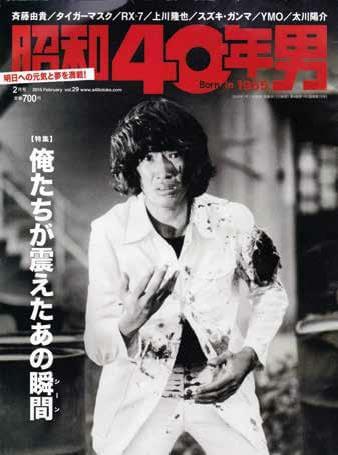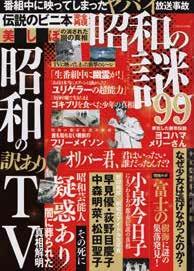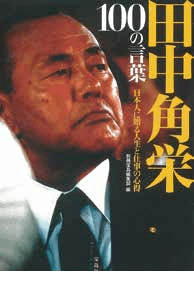Issue:

Opposite, Men Born in Showa 40’s recent cover; right, the recent mook (magazine/book
Trouble, rubble, toil and bubble
As the Heisei era enters its last months and days, the media is wringing out the last drops of Showa nostalgia.
by MARK SCHREIBER
n the not too distant future, Japan will have a new Emperor and a new nengo, or era name. And perhaps the media will eventually start looking back on the Heisei era with some sentimental attachment.
But for now, anyone with an eye on popular media will have noticed a long running nostalgic romance with the Showa Era that seems to be peaking in recent months. The reasons for this explosion of interest are manifold, but surely among them must be the huge demographic of 94 million potential readers. Roughly three out of every four Japanese alive today were born in Showa between the last week of 1926 to the first week of 1989. The oldest among them turn 90 this year; the youngest, 29.
The era was, if anything, a study in extremes: Economic depression, militarism, repression and war, followed by military occupation, economic recovery, and then prosperity, driven to a large extent by exports. Trade progressed from handicrafts silks, carvings and ceramics to cameras, electronics, motorcycles, automobiles, computers and fiberoptic components for passenger jets.
Such was the power of Showa, that today, three decades after its demise, its styles and influences not only endure, they thrive. Take the weekly magazines: Still printed in B5 size on unbleached newsprint, they are living dinosaurs, surviving with minimal evolution while other formats such as the glossy photojournalism magazines of the 1980s folded one after the next.
Shukan Shincho, almost unchanged in appearance from its launching in 1956, observed its 60th birthday last year, celebrating with a solid month of nostalgic stories. Folded inside its Feb. 22 anniversary issue was a facsimile reproduction of the magazine’s debut issue, dated Feb. 19, 1956. Priced at around ¥400 now, the magazine retailed then for just ¥30.
The debut issue contained numerous recognizable departments that have changed very little over the past 60 years, such as the halt dozen short weekly news briefs.
Several of the briefs from ’56 conveyed an unmistakable sense of dejavu. The lead item, featuring a photo of General Douglas MacArthur, touched on debate over revision of the Japanese Constitution, which in 1956 was less than nine years old.
“The sole point of contention,” the writer remarked, “seems to be between those with the opinion that since the Constitution was imposed by the military occupation it must be revised in accordance with the will of the Japanese people, and having been so imposed notwithstanding those who are in accord as far as its contents pertaining to pacifism and renunciation of war, therefore in their view making revision unnecessary.”
If a single individual can be said to dominate recent coverage of the Showa period, it would not be its imperial namesake but a prime minister who served for just two and a half years. Referred to in some quarters as the “computerized bulldozer,” Kakuei Tanaka was the enfant terrible of Japanese politics in the early 1970s. A selfmade man, a farmer’s son who left school at age 15 to help his family by working in the construction trade, his smug self confidence was popular with the voters, but not with his political rivals, and his political demise was swift and spectacular.
Last year marked the 40th anniversary of Tanaka’s arrest for accepting bribes from Lockheed Aircraft Corp, stimulating a revival of interest in the man, including a slew of books and magazine articles. One publisher, Takarajima, devoted extensive coverage to Tanaka in two magazines and a 223 page book titled One Hundred Sayings of Kakuei Tanaka, with sales of over half a million copies. As with U.S. President Trump, there was no love lost between Tanaka and the Fourth Estate: “There are three things you can trust in newspapers,” he once grumbled. “The obituaries, the stock quotations and the TV program listings.”
If there were a single common factor in the appeal of Showa nostalgia it would be postwar childhood. Eight years ago, what could be called an extreme niche product began appealing to this demographic; a glossy 4 color bimonthly publication called Men Born in Showa 40 (1965).
Editor Akira Ogasawara, who was born in 1974, says that the magazine focuses on those born in 1965 because they make up “Japan’s first TV generation.” His readers, now age 52, enjoy reliving childhood experiences such as collecting sets of premiums sold with candy. They recall faithfully watching installments of “Kamen Raida” (Masked Rider) the superhero TV series created by the late cartoonist Shotaro Ishinomori. And they remember simply adoring virginal vocalist Mari Amachi, whose singing career eventually crashed and burned. A recent “where are they now?” feature in the magazine tracked down Amachi, now age 66. The accompanying photo did a remarkable job of concealing the ravages of age.
The crimes of Showa times are also recalled as part of the good old days. In mid February, Shukan Jitsuwa’s publisher came out with a special edition titled “Hanko seimei” (letter admitting responsibility for a crime), which cataloged the previous era’s most infamous crimes and criminals.
Leading the rogues’ gallery was the audacious crook who in December 1968 impersonated a motorcycle policeman. He stopped a bank car by tricking the occupants into thinking it was carrying a bomb, and drove off with the Toshiba Fuchu factory’s ¥300 million year end cash bonus. The shipment was insured so losses were minimal, and despite a massive long running manhunt, the robber was never apprehended.
Two serial murderers and rapists, Yoshio Kodaira and Kiyoshi Okubo, and the bloodthirsty radicals of Japan’s United Red Army, are also recalled, the latter for their fanaticism and sheer persistence (some are still at large). And finally there’s the late Kazuyoshi Miura, the business man who managed to evade a murder rap over the suspicious shooting of his wife in 1981, while on a visit to Los Angeles. (He was the prime suspect in the death of a girlfriend, also in California.) Described by Newsweek as “The Man They Love to Hate,” Miura spent over a decade in prison on other charges, but the prosecutor never was able to convict him for arranging the murder of his wife. He committed suicide in a Los Angeles jail cell in 2008.
Another recent publication is the mook 99 Mysteries of Showa, from Million Shuppan. Among its contents are photos from an abandoned village in the creepy Aokigahara “Sea of Trees” one of Japan’s most notorious suicide spots near Mt. Fuji; the account of a JAL pilot who swears he encountered a UFO over Alaska; and the tale of “White Mary,” who if not Yokohama’s most famous whore certainly plied her trade the longest. In business since the Occupation years, she died at age 84 in 2005.
The national tabloid Yukan Fuji has also been giving Showa lots of heavy coverage of late. Its April 6 issue toured the north side of JR Nakano station, which it described as “a mecca with the fragrance of retro Showa.” The same page carried an installment of Shinobu Machida’s regular weekly column, “Showa Heritage,” looking back at the old three wheeled mini trucks steered by motorcycle handlebars which plied city streets until the 1960s. Machida described those days as the “eve before Japan’s modernization."

Below, the book cover of 100 sayings of Kakuei Tanaka: “There are three things you can trust in newspapers. The obituaries, the stock quotations and the TV program listings.”

Overleaf in the same Wednesday Yukan Fuji, Kenichiro Nakamaru ran a weekly lesson in “Showa Lingo,” introducing words and phrases that typified the era, like abekku (from the French avec, meaning a couple), kurukurupaa (crazy), gariben (a grind at studies), zukku (exercise shoes), suicchi on (switch on, the first time to use a new electric appliance), shakai no mado (one’s “social window,” i.e., the front zipper on trousers) and “Washington Club” (a toilet, from the initials W.C.).
Three decades after its demise, Showa’s styles and influences not only endure, they thrive
One recent entry was a popular buzz word from 1972: Asshi ni wa kakawari no nee koto de gozanzu “It’s got nothing to do with me” spoken just before the climax of each episode of the TV period drama Kogarashi Monjiro. Played by actor, and later Diet member, Atsuo Nakamura, Monjiro was a nihilistic ronin who chewed on foot long toothpicks while he roamed about the countryside. The standard tale would find people in distress pleading for his assistance, at which point he used this phrase to express his unwillingness to get involved. Invariably, though, he did the right thing, and intervened with a display of deadly swordsmanship. Monjiro’s resemblance to the characters in Sergio Leone’s spaghetti westerns was typical of the widescale artistic borrowings that were common during these years.
Economically speaking, the Showa era went out with a bang the short lived economic boom referred to as the baburu keizai. For some reason, the recent media attention has, for the large part, ignored the extravagance and excesses of that age, though the 2007 film, Baburu e Go! (Bubble Fiction: Boom or Bust), in which a time machine is used to return to the age when salarymen waved ¥10,000 bills to get the attention of spoiled taxi drivers, remains a popular staple on television. But it may be hard to get nostalgic about a time when ¥4,800 loaves of sourdough bread airfreighted from France attracted long lines of shoppers.
Indeed, Showa’s cultural and emotional winds gusted so powerfully that in a sense, the first decade of Heisei could be said to have been dragged along in its slipstream. It took the western calendar the arrival of the new millennium to stamp out the blaze. But at least during the current media revival, the embers of Showa are still glowing brightly.
Mark Schreiber was born in Showa 22 and first arrived in Japan in Showa 40.

